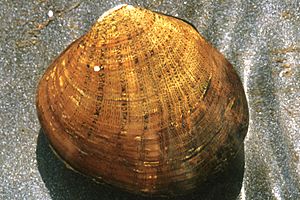Dromedary pearlymussel facts for kids
Quick facts for kids Dromedary pearlymussel |
|
|---|---|
 |
|
| Conservation status | |
| Scientific classification | |
| Genus: |
Dromus
|
| Species: |
dromas
|
The dromedary pearlymussel (scientific name: Dromus dromas) is a very rare type of freshwater mussel. It's a small aquatic animal with two shells, like a clam. You can find it in the Cumberland and Tennessee River systems in the United States. Sadly, its numbers have dropped a lot, and it's now an endangered species. This means it is at high risk of disappearing forever.
Contents
About the Dromedary Pearlymussel
What Does It Look Like?
The dromedary pearlymussel has a shell that is yellow-green. It often has broken green lines or "rays" on it. Inside the shell, the shiny lining, called nacre, can be white, pink, or even reddish.
This mussel gets its name from a special feature. Older, larger mussels often have a clear "hump" on their shell. This hump looks a bit like the hump on a dromedary camel!
Where Does It Live?
This mussel needs very specific living conditions. It lives in clear, clean, and fast-flowing water. It cannot survive in water that is dirty or has a lot of silt. Silt is like fine mud that can cover the riverbed.
How Does It Reproduce?
Like other freshwater mussels, the dromedary pearlymussel has a unique way of reproducing. It releases tiny baby mussels called glochidia into the water.
These glochidia need fish to grow up. They attach themselves to the gills of certain fish. While on the fish's gills, they develop into tiny juvenile mussels. Once they are big enough, they drop off the fish and start living on their own in the riverbed.
Fish Hosts
Some of the fish that help these mussels grow include:
- Black sculpin (Cottus baileyi)
- Greenside darter (Etheostoma blennioides)
- Fantail darter (Etheostoma flabellare)
- Snubnose darter (Etheostoma simoterum)
- Tangerine darter (Percina aurantiaca)
- Blotchside logperch (Percina burtoni)
- Logperch (Percina caprodes)
- Channel darter (Percina copelandi)
- Gilt darter (Percina evides)
- Roanoke darter (Percina roanoka)
Why Is It Endangered?
The dromedary pearlymussel was once very common in the Tennessee River. But now, only old mussels can be found there. Its population has shrunk a lot. Today, there are only about four groups of these mussels left.
It has even disappeared completely from the wild in Alabama. However, people are trying to bring it back there. The only places where these mussels are still reproducing are in the Clinch and Powell Rivers. This means they are reproducing in less than 10% of the areas where they used to live.
Threats to the Mussel
Several things have caused the dromedary pearlymussel's numbers to drop:
- Dams: Building dams on rivers changes how the water flows. This can harm the mussel's habitat.
- Silt: More silt in the water makes it harder for mussels to breathe and find food.
- Pollution: Pollution from things like sewage, coal mining, and oil and gas drilling makes the water dirty. This dirty water is very harmful to the mussels.
See also
 In Spanish: Dromus dromas para niños
In Spanish: Dromus dromas para niños


